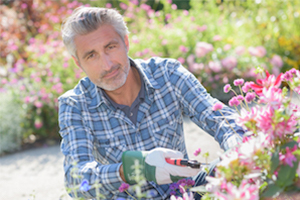
Spring is in full bloom in the northern hemisphere, with summer right around the corner. People are getting outside, and resuming activities they haven’t done through the winter months. Unfortunately, asking your spine to go ‘from zero to sixty’ is one of the factors that makes spring a peak season for back injuries. Here are a few tips to help folks spend their time golfing, boating or working in the garden instead of sitting in the doctor’s exam room.
Exercises and Spine Health
A popular but misguided belief about exercise and spine health is that exercise should cease when a patient is experiencing back pain. Although some healthcare professionals recommend that exercise should be avoided in such cases, it’s best for everyone to check with their doctor before starting a new exercise routine, and especially if back pain persists. If you’re recovering from an injury, ask your doctor to help set your course for returning to normal activity.
People who have back pain are understandably hesitant, fearing that any type of exercise or activity will make things worse. This could make you rely too much on medicines and other treatment rather than exercise, and could undermine the value of exercise for both recovery and long-term maintenance of spine health.
Moderate exercise plays a dual role: helping you recover from back pain and helping prevent future episodes of pain.
- By nourishing and repairing spinal structures, exercise helps alleviate existing back problems
- Movement and exercise help keep the anatomy of the back healthy, flexible, and strong , reducing the chance of further injury and pain
According to healthcare professionals, the muscles of the abdomen and lower back must be sound and healthy to help support your spine and reduce strain in the lower back, which itself carries the upper torso. Because the abdominal and lower back muscles don’t get a lot of strengthening exercise from activities like sports, individuals with no underlying injury or other medical condition can benefit from adding targeted exercises that are simple and straightforward, and can be performed in less than 40 minutes a session.
Recommended Exercises that Help with your Spine
Exercise 1: Neck Press against Resistance
- Lie on your back with pillow(s) supporting your head in a neutral position.
- Push your head down firmly to straighten and lengthen the spine.
- Keep chin tucked and head facing upward.
- Hold for a slow 5 count.
- Relax for a count of 10.
- Repeat 10 times or until neck muscles tire.
- Do this twice a day—perhaps before getting up and when getting into to bed.
Exercise 2: Strengthening Extensor Muscles
- Stand straight in good posture against a wall.
- Place exercise ball, about the size of a basketball, behind upper back.
- Keep feet apart and away from wall for good balance.
- Push hard with feet and legs to press back against ball.
- Keep spine, hips and knees in the same position. Only the ankle joints pivot.
- Hold for a slow 5 count and follow with a 10-second rest.
- Repeat until you feel your leg or back muscles tire.
- Slowly increase up to 15-20 repetitions.
- Repeat once every day.
Exercise 3: Chest Raises from Prone
- Lie on your stomach on the bed or floor.
- Placing a pillow under your stomach may make it easier to get on stomach and lift your head.
- Pull your shoulder blades back and together, smoothly lift head and chest, while looking straight down.
- Hold for a slow 5 count.
- Rest for 10 seconds and repeat until tired.
- Repeat once every day.
Life-style tips for Spine Health
- Reduce stress on your spine (proper ergonomics may help).
- Avoid smoking.
- Stay hydrated to maintain elasticity in soft tissue and fluidity in joints.
- Get regular sleep, ideally 8 hours a day.
- Stay active by going to the gym, walking, swimming, or playing with your kids or grandkids.
- Pay attention warning signs such as spinal stiffness or pain. See a doctor if pain persists
- Stand rather than sit when possible; support your spine when seated – be careful not to slump.
- Notice your shoes – proper foot support helps protect your spine.
- Enjoy the benefits of massage and hydrotherapy.
- Sit up straight.
- Use your leg muscles, not your back when lifting heavy items.
- Be careful when bending and reaching.
- Maintain a healthy diet and exercise regimen.
